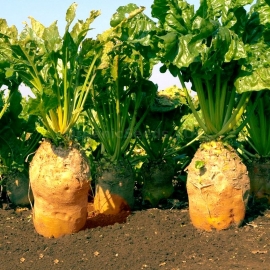
«Ursus» - Organic Fodder Beetroot Seeds
1.14 €
Semi-sugar, multi-growth variety. It is distinguished by the cylindrical shape of the yellow-orange root crop. This feature allows you to save money by hand cleaning. These roots are well kept, have a smooth surface and juicy white slightly creamy flesh.
-
Heirloom Fodder Beetroot «Ursus»
Semi-sugar, multi-growth variety. It is distinguished by the cylindrical shape of the yellow-orange root crop. This feature allows you to save money by hand cleaning. These roots are well kept, have smooth surface and juicy white slightly creamy flesh.
The capacity of the fodder beetroot Ursus is 1100-1200 c/ha.
How to Grow
Sow three seeds at 10cm (4in) intervals, 2.5cm (1in) deep in rows 30cm (12in) apart, at fortnightly intervals from mid-April to July for a succession of tender, tasty roots. Those sown from June onwards can be used for storing in winter, and some people use long or globe varieties for storing, but round roots are also suitable.
Use bolt-resistant varieties for early sowings under cloches in late February or early March. Make the first sowings outdoors with no protection in March or April.
Beetroot will grow in any well-drained garden soil but require fertile conditions, best ensured by digging in at least a bucketful of well-rotted garden compost or organic matter, and raking in a handful per square metre/yard of Growmore or other general purpose fertiliser before sowing. Early sowings benefit from protection with horticultural fleece or cloches. When the seedlings are about 2.5cm (1in) high thin out to leave one seedling per 10cm (4in) station.
Water every 10-14 days in dry spells. If plants are not growing strongly, apply 30g per square metre of high nitrogen fertiliser, such as sulphate of ammonia, and water in.
